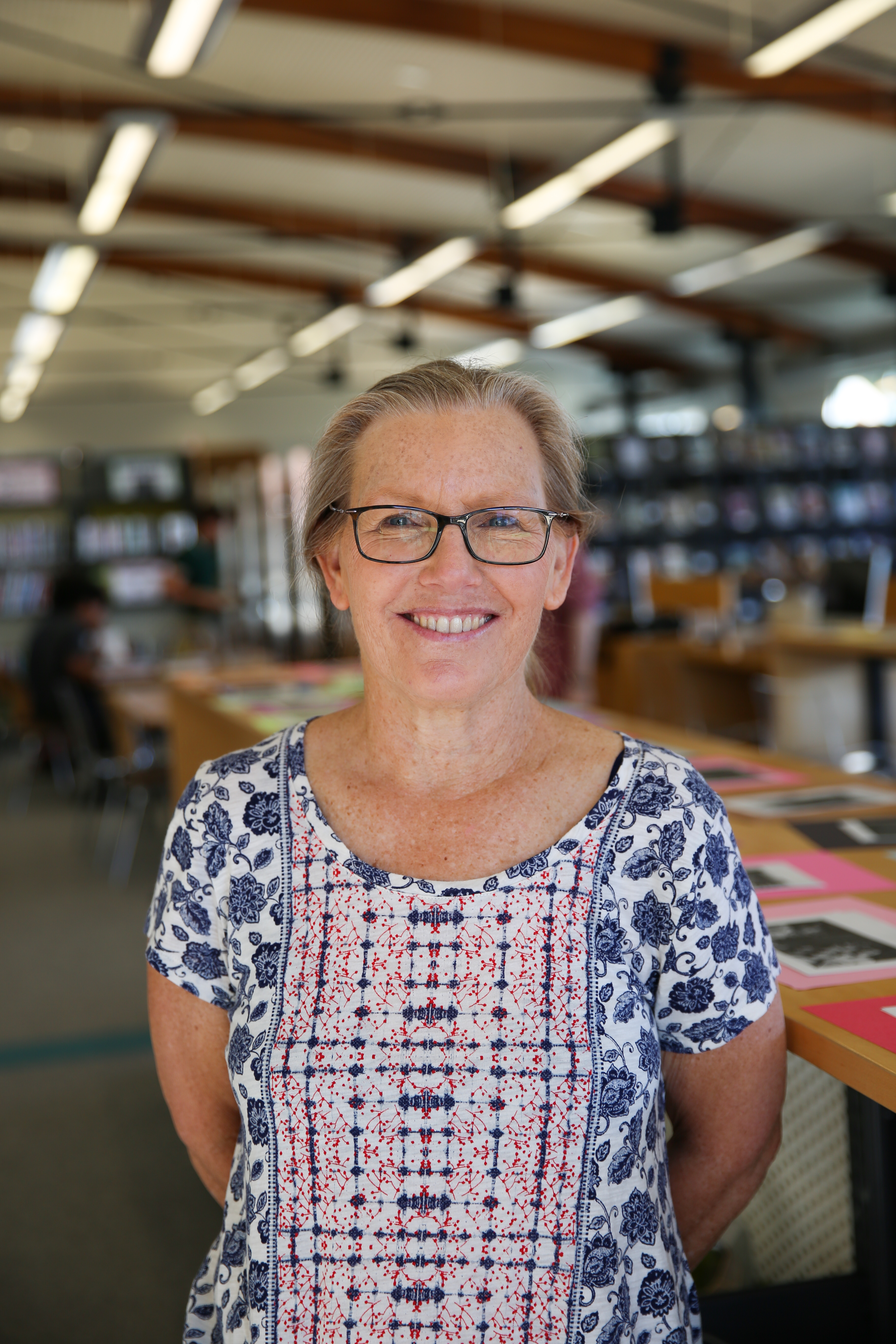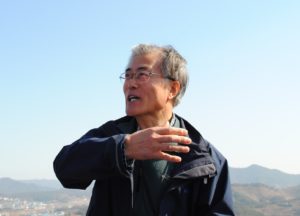
photo by JD LeRoy
Lick-Wilmerding owes the development of a great intellectual resource, its present library program, to Lissa Crider, head librarian at Lick for the past two decades. Crider is leaving Lick at the end of this school year to move to Oregon.
Crider’s path to becoming a librarian was one of coincidence and necessity. She was the first person in her family to graduate college. She says she explored a variety of courses with no idea of what career she wanted to pursue.
The journey to completing college was not easy for Crider. Earning her diploma took her eight years. She put herself through college by working at a pizza shop for five dollars an hour and also bagged groceries.
She continued to pursue a path in higher education by working towards her Bachelor of Arts in English Grammar and Composition at Cal State Long Beach. However, in the middle of a semester, her Volkswagen van broke down, and without any mode of transportation she had to drop her classes. In need of work so that she could return to school, she applied to be a secretary at an elementary school. She took the required typing test on a manual typewriter but knew that she failed. She told them that she could in fact type seventy words per minute, but the typewriter was broken. She fixed the machine on the spot; needless to say, she got the job. When the librarian position opened up after the school’s library had been closed for a year because the school lacked anyone to run it, Crider gladly filled the job. Crider says, the first day she opened the library, she stamped the books being checked out with the current date. That night she realized her mistake — she had made the books immediately overdue. “I learned about librarianship from scratch.”
She worked at the Hermosa Beach City School District for twelve years. While there she resumed classes to complete her BA.
Crider was put in charge of combining the elementary school’s library with those of three other schools. The board of education of the school district approved $10,000 from California Lottery funds to create the first digital card catalogue in Southern California—a revolutionary step towards modernity as it was the 1980s. While working on this project, Crider says she “caught the fire for running a library.” In order to consolidate the libraries she relied on the support of parents. (When she came to Lick, she instituted a similar program of parent volunteers helping to run the Lick library.) The school system in Southern California wanted a credentialed librarian. Crider enrolled in night classes at Cal State Fullerton and over the next three years earned a Masters in Library Science and a California Teaching Credential.
In 1990, Crider moved to the Windward School, an independent school in Santa Monica. The culture at Windward was a shift from the public elementary school she worked for previously. The Windward library became a gathering place for students. At Windward, Crider started meeting with a consortium library group and enjoyed the value of having the support of other librarians. While at Lick, Crider has continued to be involved with a support group of librarians from independent high schools.
Crider found her way to Lick-Wilmerding when her husband got a work transfer from Southern California to San Jose. After they moved to Northern California, Crider first taught two classes at the library school at San Jose State and managed faculty grant applications. While at San Jose State, she heard that the librarian position was open at Lick and applied for the job. She became Lick’s librarian in 1994. Crider comments that “there was no official credentialed librarian before me; in fact there wasn’t really a program, just a tiny room (now the Center) with six chairs and 6,000 books.” Crider instantly sought to create an inviting, community space for students. The first change she made was removing the circulation desk. “It was a big u-shaped desk at the entrance of the library. It was really intimidating because you’d be looking up at someone while you were trying to check out a book. It was so not representative of the egalitarian ethos of Lick-Wilmerding.” She next set up a physical atmosphere that would attract students. “I had the heater repaired; the system was broken and the room was constantly ninety degrees. I spent my entire budget that year on young adult books to encourage students to start reading.”
When Crider was hired, Lick, under the leadership of former Head of School Al Adams, was in the process of designing and constructing a new library building. At first Crider was dubious about Lick’s commitment to the library space; so many schools talk about creating library centers and renovating but never follow through. Lick had chosen SMVWM Architects to design the new library. Crider became instrumental in creating the spirit of openness and inviting access of Lick’s library space. She worked closely on the vision for the interior with Liza Pannozzo, the lead architect for the project at SMVWM. (Pannozzo is the mother of Nathan Logan ’18). Crider took charge of assuring this student-centric space fostered camaraderie and community. Crider remembers, “a day when the entire library floor was open, there weren’t any walls or windows, and the wind was blowing. We stood with hardhats on and I was stunned by the magnitude of the room. Without the books the room looked like a football field. Al turned to me and said, ‘Now do you believe me?’” The new library opened in the fall of 1997.
Crider comments, Lick’s library’s “open space, makes it welcoming. From the get-go, students found their way because they recognized it as their place.” (All of the comfy reading armchairs with which Crider furnished the library are almost always occupied — as are the computer stations and work tables. Altogether she created 90 seats.) The new building is seven times larger than the library space when Crider arrived at Lick.
Lick’s library hasn’t physically changed much other than the recent transformation of the reference shelves into work counters with bar stool seating. The reference volumes are still available, in a different location — and student research is superbly served by the online reference resources provided on the McCullough library’s webpage. Crider says, “I needed to discover more seating for students without changing the essential spirit of the library. The redesign provides 45 new work stations and better suits the needs of students. When I started at Lick I didn’t know that I could make change like that, but now I feel powerful. I can say let’s make this change for the library and Eric Temple and Randy Barnett are supportive and find the funding.”
Under Crider, Lick’s library has always been at the forefront of technology. Crider says “even before the Web we provided access to a data base called ‘Dialog.’ In the past few years, the Lick library has devoted much of its work to integrating digital platforms into the library resources.”
A key aspect of Lick’s academic resources for research — access to newspapers, other periodicals and journals, and electronic books (both fiction and non-fiction) — are the searchable digital academic databases.
Tangible, vital paper-based elements of the library endure. Students can still order any material — magazine or books or articles — they want to read.
Crider has been at Lick since inception of the present iteration of the library, working with the architects to design the space. She has created a vital, engaging, busy modern program. Some of Crider’s achievements include: expanding the physical and digital collections according to the needs of the curriculum, quadrupling the fiction section, developing a collection of 100,000 non-fiction eBooks, purchasing audiobooks in correspondence with the English, history, physics, art, or other curriculums, and creating a parent-curated archive of over 4,000 items from Lick and Lux history, including digital copies of yearbooks. Overall, Crider emphasizes that her work in the library is driven by the needs of Lick’s students.
Crider’s passion for her work stems from her love of “matching the user with the need. It fills me with a reward when I can serve students because I get to learn but I don’t have to produce anything which is really the purest form of learning. I would never leave Lick, but my husband and are moving. Our next chapter is centered on mountain biking, hiking, and bird watching in Oregon.”
Crider is unsure if she will continue working full-time, but is interested in teaching in a young adult and adult one-on-one literacy program. She comments, “I’m still in contact with one of the fifth graders that I taught to read and I realize what an impact I made in her life.” Crider also has aspirations of opening a community garden on her new acre of land in Oregon. “There’s a brand new subdivision across the street, so I’ve been ruminating over the idea that each family could take over a garden bed while making friends, and sharing the bounty of the produce that grows.”
Through her many years of service at Lick, Crider has made a lasting impact on the community with her continued devotion to helping students and transforming the library to better serve them.






